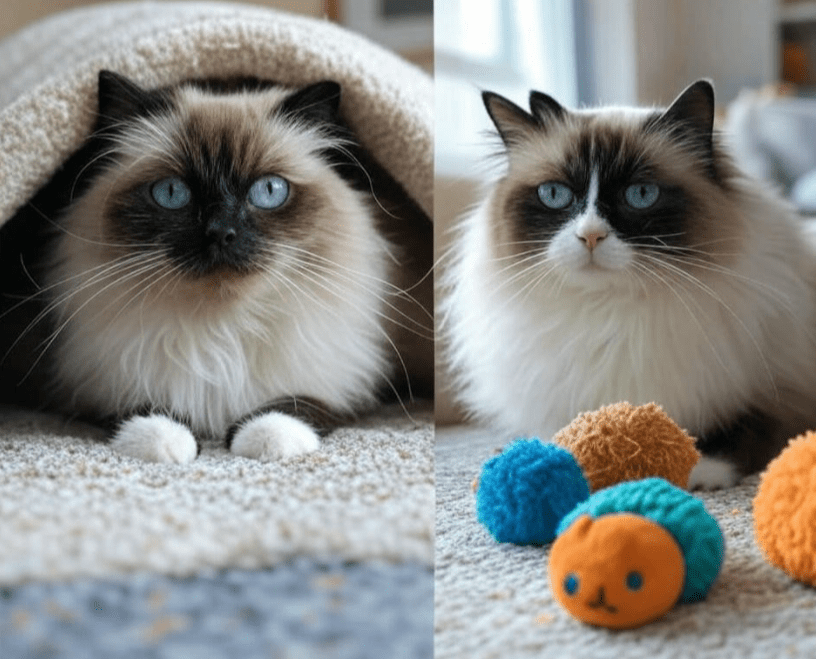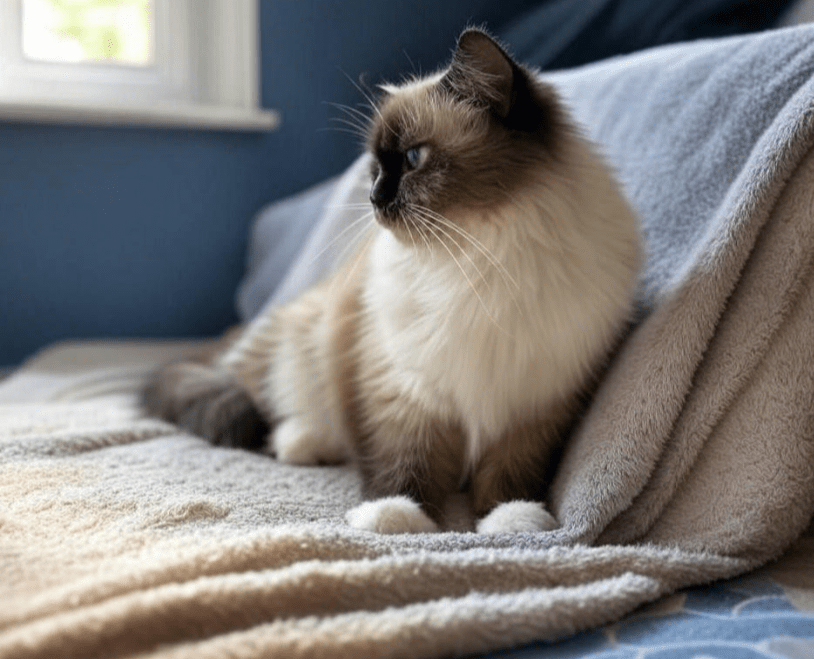
Ragdoll cats are known for their calm, affectionate nature and stunning appearance, but even these gentle felines can experience stress. As a Ragdoll cat owner, understanding the signs of stress in your pet is crucial for their well-being. Stress can lead to health issues and behavioral changes if left unaddressed. In this article, we’ll explore seven key signs that your Ragdoll cat might be stressed, along with practical solutions to help them feel safe and relaxed. Let’s dive into how you can support your beloved Ragdoll cat’s emotional health.
Why Ragdoll Cats Are Prone to Stress
Ragdolls are a unique breed, often described as “puppy-like” due to their sociable and trusting nature. However, their sensitivity to changes in their environment or routine can make them more susceptible to stress than other breeds. Factors like loud noises, new pets, or even a change in your daily schedule can impact their emotional state. Recognizing the signs early can prevent long-term issues and ensure your Ragdoll cat remains happy and healthy.
Understanding Your Ragdoll Cat’s Personality

Ragdolls thrive on consistency and gentle interactions. They often form strong bonds with their owners and can become anxious if they feel neglected or overwhelmed. Their laid-back demeanor might make it harder to spot stress at first, but subtle changes in behavior can be a clue. Let’s explore the signs to watch for.
7 Signs Your Ragdoll Cat Might Be Stressed
1. Excessive Grooming or Over-Grooming
One of the most common signs of stress in Ragdoll cats is excessive grooming. While grooming is a normal behavior, over-grooming can lead to bald patches, skin irritation, or even infections. If your Ragdoll cat is licking or scratching more than usual, it might be a sign of anxiety.
How to Help:
Create a Calming Environment: Ensure their space is quiet and free from loud noises or sudden disruptions.
Introduce Calming Aids: Consider pheromone diffusers like Feliway, which mimic natural feline pheromones to reduce anxiety.
Consult a Vet: Over-grooming can also be linked to allergies or skin conditions, so a vet visit can rule out medical issues.
2. Hiding or Withdrawal
Ragdoll cats are typically social, so if your cat starts hiding under furniture or avoiding interaction, it’s a red flag. Withdrawal can indicate that your cat feels overwhelmed or unsafe in their environment.
How to Help:
Provide Safe Spaces: Set up cozy hiding spots, like a cat bed in a quiet corner or a covered cat tree, where your Ragdoll can retreat.
Minimize Stressors: Identify and reduce potential stressors, such as new pets or frequent visitors.
Spend Quality Time: Engage in gentle play or petting sessions to rebuild trust and comfort.
3. Changes in Appetite
A stressed Ragdoll cat might lose interest in food or, conversely, overeat as a coping mechanism. Significant changes in eating habits can also lead to weight loss or gain, which may affect their overall health.
How to Help:
Maintain a Routine: Feed your cat at the same time each day to provide consistency.
Offer High-Quality Food: Ensure their diet is balanced and appealing to encourage eating.
Monitor Their Health: If appetite changes persist, consult a vet to rule out underlying medical conditions like dental issues or gastrointestinal problems.
4. Aggression or Unusual Behavior
While Ragdolls are generally docile, stress can cause them to act out. This might include hissing, swatting, or even biting—behaviors that are out of character for this breed.

How to Help:
Identify Triggers: Pay attention to what might be causing the aggression, such as a new pet or a change in the household.
Use Positive Reinforcement: Reward calm behavior with treats or affection to encourage relaxation.
Avoid Punishment: Punishing your cat can increase their stress, so focus on creating a supportive environment instead.
5. Litter Box Issues
Stress can lead to litter box avoidance, where your Ragdoll cat might urinate or defecate outside the box. This behavior is often a cry for help, signaling that something in their environment is causing discomfort.
How to Help:
Keep the Litter Box Clean: A dirty litter box can exacerbate stress, so scoop it daily and change the litter regularly.
Ensure Accessibility: Place the litter box in a quiet, easily accessible location, away from noisy appliances or high-traffic areas.
Check for Medical Issues: Urinary tract infections or other health problems can also cause litter box issues, so a vet visit is essential if the behavior continues.
6. Excessive Vocalization
If your Ragdoll cat is meowing, yowling, or making other vocalizations more than usual, it could be a sign of stress. While Ragdolls are known to be vocal when communicating, excessive noise might indicate they’re feeling anxious or unsettled.
How to Help:
Respond to Their Needs: Pay attention to what your cat might be trying to communicate—hunger, loneliness, or discomfort.
Create a Soothing Atmosphere: Play soft music or use white noise to mask stressful sounds like traffic or construction.
Engage in Play: Interactive play can help reduce anxiety and redirect their energy in a positive way.
7. Physical Symptoms of Stress
Stress in Ragdoll cats can manifest physically, with symptoms like vomiting, diarrhea, or even a dull coat. These signs often indicate that their emotional distress is affecting their overall health.

How to Help:
Monitor Their Health Closely: Keep track of any physical changes and report them to your vet.
Reduce Environmental Stressors: Ensure their environment is calm, with minimal disruptions.
Consider Supplements: Calming supplements, such as those with L-theanine or chamomile, can help, but always consult your vet before introducing new products.
How to Prevent Stress in Your Ragdoll Cat
Prevention is key to keeping your Ragdoll cat stress-free. Here are some proactive steps you can take to create a supportive environment for your feline friend.
1. Maintain a Consistent Routine
Ragdolls thrive on predictability. Feed them, play with them, and clean their litter box at the same times each day to provide a sense of stability.
2. Provide Enrichment and Stimulation
Boredom can lead to stress, so offer toys, scratching posts, and opportunities for gentle play. Interactive toys, like feather wands or puzzle feeders, can keep your Ragdoll engaged without overwhelming them.
3. Create a Safe and Comfortable Space
Ensure your home has plenty of safe spaces where your Ragdoll can relax. Cat trees, soft beds, and quiet corners can make a big difference in their comfort level.
4. Be Mindful of Changes
Introduce changes gradually, whether it’s a new pet, a move, or a shift in your schedule. Give your Ragdoll time to adjust and offer extra affection during transitions.
5. Regular Vet Checkups
Regular veterinary visits can help catch stress-related health issues early. Your vet can also provide advice on managing your Ragdoll’s specific needs.
Understanding the Emotional Needs of Ragdoll Cats
Ragdolls are deeply emotional creatures who form strong attachments to their owners. They often mirror your emotions, so if you’re stressed, your cat might pick up on it. Spending quality time with your Ragdoll, speaking to them in a soothing voice, and offering gentle petting can go a long way in reducing their anxiety.
The Role of Social Interaction
Ragdolls love companionship, but they can become stressed if they feel neglected. Make time each day to interact with your cat, whether through play, grooming, or simply sitting together. If you’re away for long periods, consider a pet sitter or a companion pet to keep them company—though introduce new pets slowly to avoid additional stress.
Recognizing When to Seek Professional Help
If your Ragdoll cat’s stress signs persist despite your efforts, it might be time to consult a professional. A veterinarian can rule out medical issues, while a feline behaviorist can provide tailored strategies to address anxiety. Don’t hesitate to seek help if you’re concerned about your cat’s well-being.
Common Stressors for Ragdoll Cats and How to Address Them
1. Loud Noises
Ragdolls are sensitive to loud sounds, such as thunderstorms, fireworks, or construction noise. To help, create a quiet retreat space and use white noise to mask disruptive sounds.
2. New Pets or People
Introducing a new pet or having frequent visitors can be overwhelming. Allow your Ragdoll to adjust at their own pace, and provide a safe space where they can retreat if needed.
3. Changes in Routine
A sudden change in your schedule, such as working from home less often, can unsettle your Ragdoll. Gradually introduce changes and maintain as much consistency as possible.

4. Lack of Stimulation
Ragdolls need mental and physical stimulation, but their gentle nature means they prefer low-intensity activities. Offer toys and playtime that suit their personality, avoiding overly aggressive or fast-paced games.
Conclusion
Recognizing the signs of stress in your Ragdoll cat is the first step to ensuring their happiness and well-being. From excessive grooming to litter box issues, these signs are your cat’s way of communicating that something isn’t right. By creating a calm environment, maintaining a consistent routine, and addressing their emotional needs, you can help your Ragdoll feel safe and secure. If you notice persistent stress signs, don’t hesitate to seek professional help from a vet or behaviorist. With the right care, your Ragdoll cat can thrive, bringing joy to your life for years to come.




